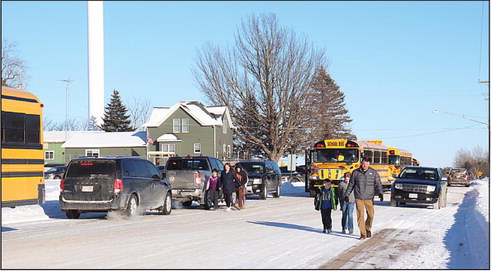Clark County to draft ordinance to regulate wind/solar farms
Clark County will develop an ordinance regarding potential wind and solar energy farms, but its zoning administrator said not to expect that such a rule will prevent any future 500-foot wind turbines towering over the landscape. Counties have very little power to control where wind and/or solar farms are located, said Derek Weyer, but having a local ordinance might at least give the government some say in the process of how a facility operates or is removed when no longer in use.
The county Board of Supervisors voted 28-0 on May 20 to have Weyer and county attorney Jake Brunette draft an ordinance “that regulates the application, development, operation, and decommissioning of wind and solar energy systems.” Clark County currently has no such rule in place, and Weyer said at least two wind energy companies have explored options in the county in the past few years and recent interest has been shown in solar farms. The ordinance will be drafted and brought back to the full Board for future consideration.
State administrative code largely governs wind farms in the state, Weyer and Brunette told the Board last week, and neither counties nor townships can impose more stringent rules. Since the state codes that took effect in 2012 are largely favorable to wind farms being developed anywhere a developing company wants one, there is nothing a county can do to put the brakes on a project.
In 2017 a company known as EDP Renewables showed interest in developing a wind farm with about 30 turbines in the township of Loyal. That plan was abandoned in 2018, but late in 2020 and earlier this year, RWE Renewables began contacting landowners in the northern county towns of Hoard and Mayville to gauge possible interest in property leases for a wind farm project.
Brunette said the process of writing the state codes a decade ago was influenced by those pushing renewable energy sources, and that’s why the rules are quite liberal for allowing wind farm projects. “It’s clear that the wind energy systems had a good lobbying force,” when the rules were written, Brunette said.
Such as those rules are, Weyer said the county may enact an ordinance, but it can’t carry any weight to prevent a project. If a wind farm company concludes it has a favorable location and can convince enough landowners to sign leases allowing turbines on their property, the county can’t intervene.
“This wind ordinance will not stop a wind farm from being developed in the county,” Weyer said. “If you don’t want wind farms in the county, it has to happen at the landowner level. The county cannot stop it.”
Weyer said both companies that have shown interest in recent years in the county have talked privately to landowners about leases for their property. Weyer advised landowners to be cautious before agreeing to anything.
“Make sure you know what you’re signing,” he said. Wisconsin currently has 10 operating wind farms, Weyer said, with a total of 437 turbines spinning at heights of as much as 600 feet. While they produce renewable energy that can be sold to existing power companies, they also create concerns such as potential declines in property values, blinking light disruption (the towers proposed in the Hoard/Mayville project would be 600 feet in height, and would require flashing lights), shadow flicker (the moving shadows caused by the whirling turbines), local television signal disruption, and low frequency noise issues.
Regarding solar energy farms, Weyer said there has been more interest in them recently. They are not regulated yet by state codes, and companies have begun to install large solar panel arrays to capture the sun’s energy. He cited a 13,000-acre farm developed recently in Indiana.
While solar farms would not involve the towering, aesthetically disruptive wind turbines, they could include large congregations of solar panels in an area. In recent months, Weyer said he has gotten calls from three different solar energy developers that have asked for zoning information in the towns of Eaton, Loyal and Colby.
“In the last six weeks, I’ve had more calls on solar farms than I did in my first three-and-half years here,” Weyer said.

